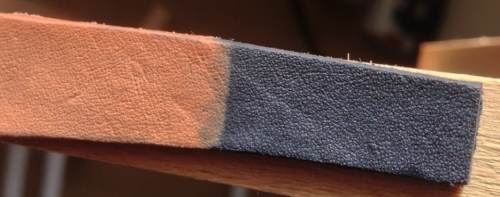COLOURING BLACK LEATHER
I have an article in the saddlery demonstrations about why you shouldn't try to dye your own leather so hopefully you have read that and now wish to try a safer home made alternative on your Black leather?
I must admit I have never tried this but it does seem a safer alternative to the aniline dyes.
The following was written by someone else who has tried it but they did try it on what looks like it could be new piece of natural (non dyed) leather which would take any colour far more easily than used dyed veg tanned leather that is possibly full of fats and greases.
BUT if you have a saddle flap that has faded due to wear from the stirrup leathers so the leather is worn and dry, it might work for that or leather boots that have faded.
Then seal the colour it with either an acrylic fluid called Resoline (will make your leather go shiny) or use some leather conditioner to seal it in once the colour has dried. I would use leather conditioner to try to seal it in as you don't want the Black colour coming off on your White jods!
All I can say is, try it and see on a test area first to determine the results before you go slapping it on all over it.
Here is the leatherworker's article
I thought I'd share some research and practical experience in making an ancient leather colouring.
Vinegaroon (or Vinegar Black, or Ferric Acetate, or Iron (III) Acetate, take your pick) is a clear, brownish solution which reacts with the tannins in naturally tanned leather to form black and grey coloured compounds. It's not a dye as such in that it contains no pigments - the colour is permanent and runs right through the full thickness of the leather.
I had a stab at making a batch last night: below is my recipe and results, along with a few other bits which people might find interesting or useful. The basic recipe is all over the Internet: iron metal dissolved in vinegar.
1) I started with a fine steel wool pad (Robert Dyas) and a 350ml bottle of the strongest vinegar I could find (Tesco white wine vinegar, 6% acidity).
2) I shredded about half the steel wool into inch-long tufts and put it in a jar. Some Internet posts suggest rusting the metal first: I disagree - the iron needs to be as free as possible to react with the vinegar and rust is not soluble in water so will protect the underlying metal from the acid to some degree.
3) I added the vinegar and then decided to jazz things up a bit. Again, Internet wisdom will tell you it takes anything from 3 days to 3 months to make effective vinegaroon...
4) There are two ways to speed up chemical reactions which I dimly recall from school: raise the temperature or add a catalyst. I did both.
5) I used hot tap water and boiling water from the kettle to fill the kitchen sink to a sensible depth with water at 70-ish degrees C. Thankyou Heston Blumenthal: I finally found a use for your kitchen thermometer. I then stood the jar in the water bath and loosened the lid (important: the solution gives off gas - hydrogen, I'm guessing - as it develops, and you don't want the jar breaking as pressure builds up).
6) After 4 hours I had an idea for a catalyst (well, strictly speaking I suppose it's an additional reagent, not a catalyst. Let's just say I'm using the term loosely, yes?  ). The compound I'm trying to make has a lot of oxygen in it: I could add this by bunging in some hydrogen peroxide. I used a 3% peroxide solution which disinfects my contact lenses as its day job. I added about 75ml to the jar, which provoked an immediate and vigorous fizzing. I gave the whole soupy mess a stir, reheated the water bath and went to bed.
). The compound I'm trying to make has a lot of oxygen in it: I could add this by bunging in some hydrogen peroxide. I used a 3% peroxide solution which disinfects my contact lenses as its day job. I added about 75ml to the jar, which provoked an immediate and vigorous fizzing. I gave the whole soupy mess a stir, reheated the water bath and went to bed.
7) 8 hours later, I had a jar of greenish-brown, clear liquid with some gunge on the bottom and some steel wool floating on top. Quite a strong vinegar smell so I think there's some way to go before all the acid is used up. I've reheated the water bath again and will check back when I get home tonight.
8) I couldn't resist the opportunity to test it though! I dipped an off cut of the lighter veg tan hide: colour change was near enough instant - it went a lovely deep greyish black - see photo. The leather is still damp from being rinsed but is otherwise untreated...



